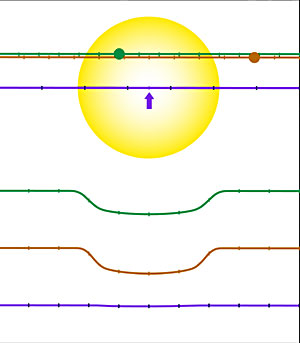And the exoplanet news just keeps on coming.
Two days ago a European planet-hunting team announced finding a Sun-like star with at least five and maybe seven planets, based on the star's complex gravitational wobbles as tracked by the super-precision HARPS spectrograph in the Andes.
Now the science team for NASA's Kepler probe has performed radial-velocity followups at the Keck Observatory confirming that a different Sun-like star, known as Kepler 9, is transited by the silhouettes of two planets. And the team determined an accurate mass for each of them.

A model of the Saturn-mass bodies Kepler 9b and 9c (red and green), and an unconfirmed super-Earth candidate closer in, transiting their sunlike star. The light curves at bottom show the relative amount of dimming that each causes as it blocks a little of the star's face. The small candidate's effect is extremely slight: a dimming of only about 200 parts per million (0.0002 magnitude). The ticks mark equal amounts of time.
Kepler Science Team
But that's just the start. The timing of each planet's transits is changing. The orbital period of one world is slowing down and the other is speeding up. The two planets are gravitationally interacting with each other. Strongly.
They circle the star with periods of 19.2 and 38.9 days. Look carefully at those numbers; they form nearly a 2:1 ratio. That's no coincidence. Objects locked into such orbital resonances with each other are common in our solar system, such as among the moons of Jupiter and among asteroids locked to major planets' periods. Resonances are also proving to be common among extrasolar planets, as more and more multi-planet systems are discovered.
But look again; the orbital ratio is not quite exact. That's normal too. Objects in orbital resonances tend to "librate" (oscillate back and forth) by up to a few percent around the exact numerical value.
Hot Saturns
Kepler 9b and 9c, as they are known, are both gas giants a little smaller and a little less massive than Saturn. The inner one, 9b, weighs in at 0.25 of a Jupiter mass (80 Earths) and the outer one at 0.17 Jupiter mass (54 Earths), with an uncertainty of just a few percent. They orbit 0.14 and 0.22 astronomical units from the star, closer than Mercury orbits the Sun (0.39 a.u.). That means they pass pretty close to each other. And so they should tug on each other significantly.
Sure enough, the team found that the inner planet's orbital period is increasing by 4 minutes per orbit, and the outer one's is decreasing by 39 minutes per orbit. That's a lot. The two planets would soon meet and crash, or go chaotic, unless those values change and reverse periodically. The team estimates, by running simulations, that they oscillate back and forth around the exact 2:1 ratio about every 4 years. That's how the system has survived an estimated 2 billion years or more.
"In addition to the slow change in orbital period," they write in their paper, "the times between successive pairs of transits of Kepler 9b also show an alternating pattern with an amplitude of 2 to 4 minutes." This is due to "the alternating position of the outer planet at the time of transit with respect to the inner planet, and it scales with the mass of the outer body." Again, the whole gravitational picture falls neatly into place.
A Planetary Decoder Ring
All this has lots of implications. At a press conference this afternoon, lead author Matthew J. Holman (Harvard-Smithsonian Center for Astrophysics) stressed that as Kepler finds more and more multiple systems with smaller and smaller planets, transit-timing variations "will be particularly valuable for estimating the masses of small planets." That includes Earth-mass worlds, which are too puny to create a radial-velocity wobble in their stars big enough to measure. (Detailed paper on such multi-planet opportunities.)
Gravitational interactions could also reveal the presence of additional worlds that do not transit their star but tug on those that do.
Moreover, the team writes, "The detailed dynamics of a resonant system probe the system's formation." At the press conference, Alycia Weinberger (Carnegie Institution of Washington) explained why.
It's clear, she said, that exoplanets in resonant orbits didn't form that way but fell into the resonance and became stuck there while migrating in toward their star from farther out. "Planet migration" is expected early in a system's history, when the original protoplanetary disk of gas and dust is still massive enough to exert a gravitational effect. Migration can also occur somewhat later, if planets interact with large numbers of small bodies such as asteroids or Kuiper Belt objects. Some degree of migration is strongly suspected in our own solar system's early history.
A Super-Earth too?
There's more. In addition to Kepler 9's two confirmed giants, the team also identified signs of a third, much smaller body that also transits the star much closer in. It's perhaps 1.5 Earth diameters in size and seems to cross the star every 1.6 days, implying a distance from it of only 0.027 a.u. If it's real, it's broiling at a distance of just a few times the star's own radius. More observations are needed to confirm it. A hot super-Earth of this diameter would probably possess 3 or 4 Earth masses of rock and iron .
Kepler 9 is a G2 star about 2,300 light-years away in Lyra. It shines at a very dim magnitude 13.9, currently almost straight overhead (as seen from North America and Europe) in the early-evening sky.
 1
1
Comments
Tim
August 27, 2010 at 7:47 am
A related technical paper on these data:
http://arxiv.org/abs/1006.2763
You must be logged in to post a comment.
You must be logged in to post a comment.